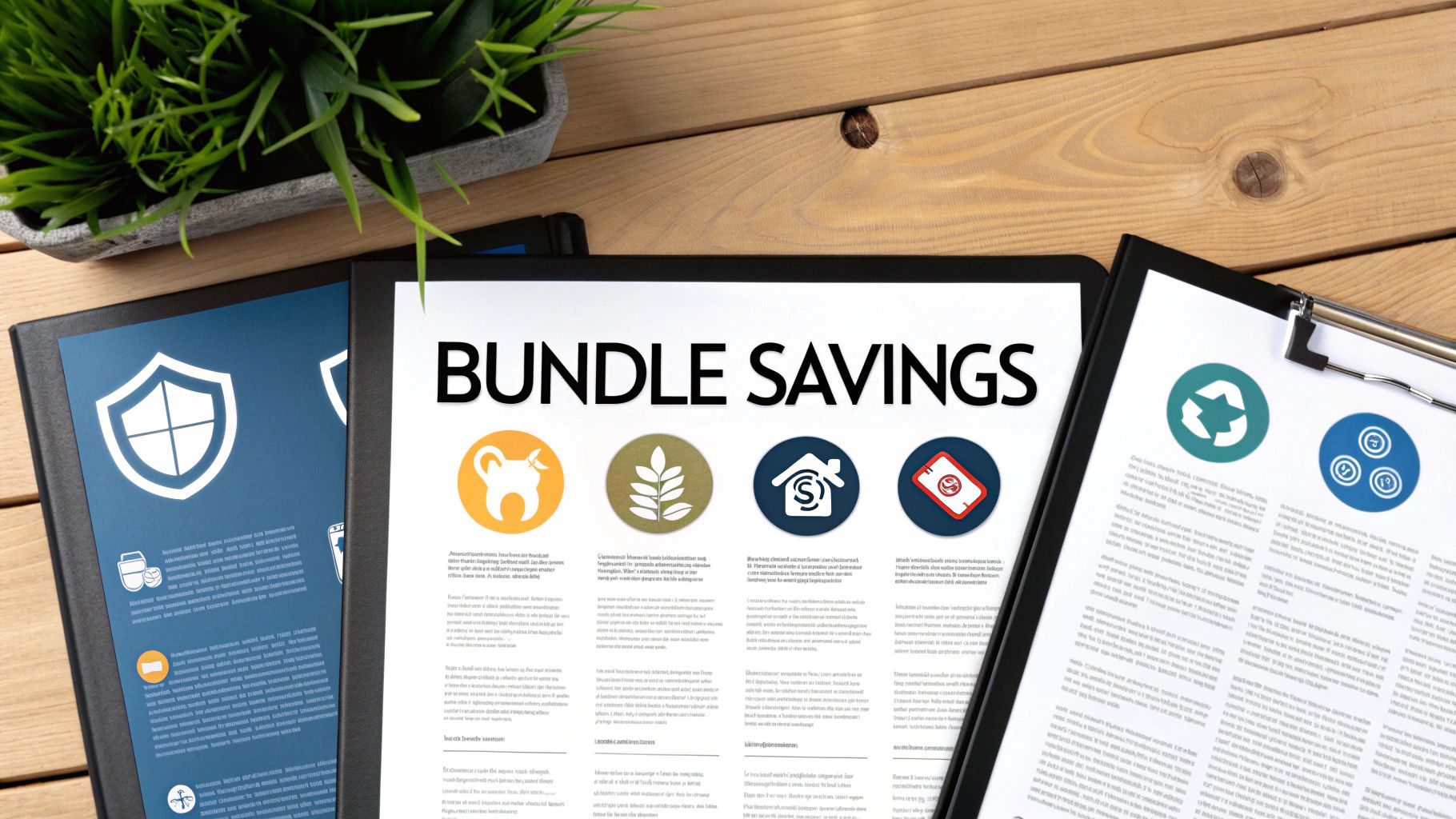Understanding the Hidden Drivers of Your Premium Costs

Insurance premiums are calculated through complex risk assessments. These assessments take a variety of factors into account, some less obvious than others. Let's explore these key drivers to better understand their impact on your insurance costs.
Personal Factors that Influence Premiums
Several personal factors play a significant role in how your insurance premiums are determined. These include your claims history, location, and credit score. A history of accidents or claims will typically result in higher premiums. This is because it suggests a higher probability of future claims.
Living in an area with a higher crime rate or a greater risk of natural disasters can also increase your insurance costs. Insurers must account for the increased likelihood of claims in these areas.
Your credit score can also affect your insurance premiums in many states. Insurers often consider individuals with lower credit scores to be higher risks. Statistically, those with lower credit scores tend to file more claims. Therefore, improving your credit score can be a useful way to lower your insurance costs. Understanding the different types of insurance and their associated rates is essential for minimizing premiums. For those interested in term life coverage, comparing term life insurance rates is a good starting point.
Market Forces and Their Impact
Beyond individual factors, larger market forces also have an effect on insurance premiums. The degree of competition among insurance providers in your area can greatly influence pricing. Greater competition can result in lower premiums as companies try to attract new customers.
Global insurance market trends also come into play. Global commercial insurance rates experienced shifts recently, with a 2% decline in Q4 2024. This was the second consecutive quarter of decreasing rates after seven years of increases. The decrease was attributed to increased competition and improved risk modeling. More detailed statistics can be found here.
Even with these declines, however, the core factors involved in premium calculations remain fundamentally unchanged. Understanding these underlying factors remains important for managing your insurance costs.
Understanding the Math Behind Your Premium
By understanding the different factors that affect your insurance premiums, you can be proactive about managing your expenses. This allows you to make educated decisions about your coverage and discover potential savings. Rather than depending on general advice, you can concentrate on the particular drivers that are most relevant to your individual circumstances.
Leveraging Smart Tech to Slash Your Insurance Costs

Technology offers significant opportunities to reduce insurance premiums. This empowers policyholders to take control of their insurance expenses. Let's explore how smart tech can help you save.
How Telematics, Smart Homes, and Wearables Can Save You Money
Telematics devices in your car track driving habits like speed, mileage, and braking. This data allows insurers to assess risk more accurately, often rewarding safe drivers with lower premiums—sometimes up to 30%.
Similarly, smart home systems can significantly reduce property insurance premiums. Features like smoke detectors, burglar alarms, and water leak sensors minimize the risk of damage, leading to discounts of 15-20%.
Think of a smart home system as a silent guardian, constantly monitoring for hazards and mitigating risks. This proactive approach protects your home and reduces insurance costs.
Wearable health monitors can also contribute to lower life insurance premiums. By tracking activity levels, sleep, and other health metrics, these devices provide insurers with a more comprehensive picture of your health. This can lead to substantial discounts, particularly for those with healthy lifestyles. For more tips on saving on car insurance, check out this helpful resource: How to master….
Integrating advanced technology like risk modeling and data analytics further reduces premiums. For example, in property insurance, advanced catastrophe modeling refines risk assessments, increasing competition and lowering rates. In Q3 2024, property insurance rates dropped by 2%, contrasting with earlier 3% increases in Q1 2024. This integration enhances risk assessment and leads to better pricing for policyholders. You can find more detailed statistics here.
To understand how different technologies can impact your premiums across various insurance types, take a look at the table below:
This table compares different technologies and their potential impact on premiums across various insurance categories.
Premium-Reducing Technologies by Insurance Type:
| Insurance Type | Technology | Potential Savings | Implementation Difficulty |
|---|---|---|---|
| Auto | Telematics | Up to 30% | Easy |
| Home | Smart Home Systems | 15-20% | Medium |
| Life | Wearable Health Monitors | Varies based on health data | Easy |
This table highlights how integrating smart technology can lead to significant premium savings across different insurance types. While telematics and wearables are relatively easy to implement, smart home systems may require more effort. However, the potential savings make the investment worthwhile.
Choosing the Right Tech and Insurer
Not all insurers offer the same discounts for tech adoption. Research and compare different providers to find those with the most generous tech-based discounts.
Once you’ve identified the right insurer, document your technology adoption clearly. Provide necessary documentation, like installation confirmations or usage reports, to receive maximum premium reductions.
By carefully selecting both the technology and the insurer, you can lower your insurance costs and enjoy a safer, smarter lifestyle.
The Art of Strategic Policy Bundling That Insurers Don't Advertise

While most insurance companies advertise basic bundling discounts, there are more strategic combinations that can significantly lower your premiums. These advanced bundling strategies aren't widely publicized, but they can result in substantial savings.
Uncovering Hidden Bundling Opportunities
Beyond the common practice of bundling home and auto insurance, other powerful pairings can unlock further discounts. For instance, bundling auto and umbrella insurance can often yield greater savings than the standard auto and home bundle.
Additionally, some insurers offer substantial discounts for bundling less common combinations, such as pet insurance with home insurance. These less common pairings can lead to savings of 15-25% beyond standard bundles. This is similar to buying in bulk at the grocery store; the more you buy together, the more you save per item.
Bundling different insurance policies allows insurers to streamline their administrative costs and offer you more competitive pricing.
Maximizing Savings With Loyalty Programs and Affiliations
Many insurers offer loyalty programs and recognize professional affiliations that can further reduce your premiums. Some offer discounts to members of specific professional organizations, alumni associations, or even employer groups.
Leveraging these affiliations is a simple yet effective way to lower insurance costs. Think of it like using a coupon at checkout—it's a small step that can result in significant savings.
Be sure to inquire about any potential affiliations that might qualify you for additional discounts when obtaining quotes.
Effective Negotiation Strategies for Bundling
Knowing how to phrase your bundling requests can also maximize your savings. Instead of simply asking about bundles, inquire about all available discounts. This includes those related to specific policy combinations, loyalty programs, and professional affiliations. This comprehensive approach can uncover hidden savings opportunities.
For example, instead of saying, "Do you offer a discount for bundling my home and auto insurance?", try saying, "I'm interested in exploring all available discounts, including those for bundling policies, loyalty programs, and any affiliations I might qualify for. I'm a member of [mention your affiliation], for instance." This more specific phrasing can often lead to greater discounts.
Strategic Bundling vs. Splitting Policies
While bundling can be an effective strategy to reduce insurance premiums, it's not always the best approach. Sometimes, strategically splitting policies across different carriers can result in lower overall costs.
This is especially true if one insurer offers a significantly lower price for a specific type of coverage. It's essential to evaluate both bundling and splitting options to determine the most cost-effective approach for your individual needs. This careful consideration ensures you secure the best possible rates without compromising necessary coverage.
Location Matters: Regional Tactics That Significantly Cut Premiums

Your location plays a significant role in determining your insurance premiums. Insurance is a localized market, shaped by state and even city-specific regulations, risks, and competition. This creates unique opportunities for premium reduction based on where you live.
State-Specific Programs and Subsidies
Many states offer programs and subsidies designed to lower insurance costs. For example, some states offer discounts for home improvements that increase safety, such as installing storm shutters or reinforcing roofs. These discounts encourage homeowners to mitigate potential risks.
Some states also provide subsidies for specific types of insurance, like earthquake insurance in California or flood insurance in flood-prone areas. These subsidies make essential coverage more affordable for residents in high-risk locations. Understanding your state's programs can significantly impact your insurance expenses.
Regional Variations in Driving Courses and Discounts
The effect of completing a defensive driving course on your auto insurance premium varies regionally. Some states offer substantial discounts, while others offer minimal reductions. Researching your area's specific regulations is crucial.
Discounts for safety features like anti-theft devices or airbags also vary based on regional car theft rates and accident statistics. Insurers adjust pricing based on local risk factors, influencing the discount size for these safety features.
Competitive Landscape and Regional Regulations
The level of competition among insurers in your region directly affects premiums. Highly competitive markets often result in lower prices as companies compete for business. Conversely, less competitive markets tend to have higher premiums due to limited consumer choice.
State regulations also play a significant role. Some states have stricter rules on insurer pricing and coverage options, influencing premium costs. Understanding these regulatory differences can help you make informed choices.
International Considerations and Local Market Trends
These principles also apply outside the United States. Researching local regulations, subsidies, and competitive dynamics in your country or region is crucial for finding lower insurance premiums.
The global insurance market experiences regional variations in premium shifts. For example, the Americas saw a 10.1% increase in gross written premiums (GWP) in 2023, while Asia and Oceania experienced declines. More detailed statistics can be found here. Reducing premiums often depends on factors like technology and local market dynamics. Where competition is strong and risk assessment tools are advanced, insurers can offer more competitive pricing. This localized approach is vital when global trends don't accurately reflect local conditions.
By carefully considering these regional factors, you can effectively lower your insurance costs. This localized approach offers significant savings opportunities often overlooked. Remember to explore all available resources and compare options to find the best possible rates in your area. This diligent research empowers you to effectively manage your insurance expenses.
Risk Mitigation Moves That Actually Pay Off
Investing in risk reduction can have a substantial impact on your insurance premiums. However, it's important to understand which strategies offer the best return on investment. Let's explore how different actions affect insurance costs across various policy types.
Home Insurance: Protecting Your Investment and Lowering Premiums
For homeowners, certain improvements offer greater premium reductions than others. Installing a security system, for instance, can lead to notable savings. This proactive measure reduces the risk of theft and, consequently, the likelihood of filing a claim.
Strengthening your home against natural disasters also provides financial benefits. Reinforcing your roof or installing storm shutters can result in substantial discounts, especially in high-risk areas. These improvements demonstrate a commitment to risk management, making your property more resilient to damage.
While aesthetic upgrades may boost your home's market value, they generally don't significantly impact insurance premiums. This is because they don't directly mitigate the risk of covered events like fire or theft.
Auto Insurance: Safe Driving and Smart Choices
Safe driving habits are paramount when it comes to auto insurance. Insurers frequently reward drivers with clean records and accident-free histories with lower premiums. Many companies now use telematics programs that monitor driving behavior and offer discounts based on safe practices. For more ways to save on car insurance, check out this article: How to master….
Investing in safety features also leads to premium reductions. Anti-theft devices, anti-lock brakes, and multiple airbags can all lower your insurance costs. These features reduce the risk of theft and lessen the severity of accidents, making your vehicle less risky to insure.
Health and Life Insurance: Investing in Your Well-being
In the realm of health and life insurance, preventive care and healthy lifestyle choices can lead to substantial savings. Many insurers provide discounts for joining wellness programs, undergoing regular checkups, and maintaining a healthy weight. These actions demonstrate a proactive approach to health management, minimizing the risk of future health complications.
Quitting smoking is another effective method for lowering life insurance premiums. Smoking significantly elevates the risk of various health problems, leading to higher premiums. By quitting, you demonstrably reduce this risk and unlock significant savings.
The table below, "Risk Mitigation Actions and Premium Savings," outlines specific risk reduction actions and their typical impact on insurance premiums. It also provides an estimate of implementation costs for each action.
| Insurance Type | Risk Mitigation Action | Typical Premium Reduction | Implementation Cost |
|---|---|---|---|
| Home | Security System | 5-20% | Varies |
| Home | Storm Shutters | Up to 15% | Varies |
| Auto | Safe Driving | Up to 30% | None |
| Auto | Anti-theft Device | 5-25% | Varies |
| Health | Wellness Program | Varies | Varies |
| Life | Quitting Smoking | Varies | None |
As this table highlights, the cost of implementing risk mitigation measures can vary significantly, while the potential savings on premiums are often substantial.
By focusing on risk mitigation strategies that offer the best return, you can effectively reduce your insurance expenses without sacrificing essential coverage. This approach allows you to make informed decisions that benefit both your finances and your overall well-being. Remember to compare quotes from different insurance providers to secure the best possible rates.
Timing Your Insurance Moves for Maximum Savings
Timing plays a critical role in securing lower insurance premiums. Just like the stock market or real estate, insurance prices can shift. Understanding these cycles helps you find the best rates.
Macroeconomic Factors and Insurance Pricing
Macroeconomic factors, like inflation and interest rates, have a significant impact on insurance pricing. Higher interest rates, for example, can actually lead to lower premiums. This happens because insurers earn more on their investments and can pass those earnings on to policyholders. On the other hand, periods of high inflation typically increase claims costs, which pushes premiums up. As inflation cools, premiums may stabilize or even decrease.
The recent rise in interest rates has been beneficial for the insurance industry. Global non-life premiums are expected to grow by 3.3% in 2024, as insurance prices moderate after inflation-driven increases. Higher interest rates improve insurers’ investment returns, which can translate to lower premiums. Learn more about these trends in the Swiss Re Institute's sigma report.
Seasonal Trends in Insurance Premiums
Similar to retail stores offering seasonal sales, some insurance types have seasonal pricing trends. For instance, auto insurance rates might be higher during the summer months. This is due to increased travel and a higher risk of accidents. Conversely, rates may be lower in the winter when driving is less frequent. Knowing these trends lets you time your policy purchases or renewals strategically.
Insurers' Fiscal Calendars and Pricing Strategies
Understanding an insurer's fiscal calendar offers insights into their pricing strategies. At the end of a fiscal quarter or year, insurers are often motivated to reach sales targets. They may offer more competitive rates during these periods. Timing your purchase or renewal to align with these times could secure a better deal. It's similar to negotiating the price of a car; knowing the dealer's sales targets can give you an advantage.
Recognizing Buyer's Markets in Insurance
Like the real estate market, there are buyer's markets in insurance. A buyer's market happens when competition increases among insurers. This often leads to lower premiums and more flexible policy options. Recognizing a buyer's market lets you capitalize on these conditions. This means researching different insurers, comparing quotes, and negotiating the best terms.
Timing your insurance decisions strategically can result in significant savings. Considering macroeconomic factors, seasonal trends, and insurers' fiscal calendars can help you get the most for your money. Planning your insurance moves is like a gardener planning for the seasons; strategic timing maximizes your financial harvest.
Negotiation Techniques That Insurance Professionals Use Themselves
Beyond standard discounts, insurance professionals often employ savvy negotiation strategies to secure even lower premiums. These techniques can potentially shave off an additional 15-30% beyond the typical discounts available to qualified individuals. Let's explore these insider approaches.
Presenting Your Risk Profile Strategically
Insurance professionals understand the art of presenting a risk profile in the most favorable light. They use specific language that resonates with underwriters, emphasizing safety measures and responsible behavior. For example, instead of simply mentioning a security system, they highlight its specific features, like motion detectors or professional monitoring, and explain how these features mitigate risk. This proactive approach demonstrates a commitment to risk management.
Thorough documentation also plays a vital role. Providing detailed records of safety measures, home maintenance records, or even documented health improvements can significantly strengthen your negotiating position. Think of it like presenting evidence; the more compelling your documentation, the stronger your case becomes.
Leveraging Competing Quotes and Timing
Insurance professionals are adept at using competing quotes to their advantage. Presenting multiple quotes from different insurers demonstrates that you've done your research and are willing to explore all available options. This can incentivize insurers to offer more competitive pricing to win your business.
Timing your negotiations strategically can also yield savings. Just as retailers have sales, insurance companies often have periods where they are more eager to acquire new customers. Aligning your application or renewal with these periods can often unlock special pricing or promotions. For more tips on timing, check out this helpful resource: How to master….
Identifying Flexible Policy Aspects
Experienced insurance negotiators know which aspects of a policy offer the most flexibility for cost reduction without compromising essential coverage. They understand the nuances of different coverage levels and deductibles. For instance, opting for a higher deductible can lower your premium, but it's crucial to ensure you can comfortably afford the higher out-of-pocket expense if you need to file a claim.
They are also skilled at identifying unnecessary add-ons or riders that might be inflating your premium without providing significant value. This careful evaluation ensures you're paying only for the coverage you truly need, optimizing your insurance costs.
Negotiating Like a Pro
By adopting these negotiation techniques, you can approach insurance discussions with confidence and secure the most favorable rates. Think of it like negotiating the price of a car; understanding the market and your own needs empowers you to make informed decisions.
Remember, these are the very methods insurance professionals use to lower their own premiums. By applying these strategies, you gain a significant advantage in securing affordable and comprehensive coverage.
Comments are closed.